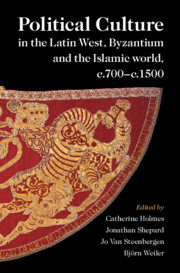 Political Culture in the Latin West, Byzantium and the Islamic World, c.700–c.1500
Political Culture in the Latin West, Byzantium and the Islamic World, c.700–c.1500 Sources
from Part I - Sources
Published online by Cambridge University Press: 11 August 2021
The Qurʾan, and the problems of its interpretation, is even more central to Islamic political culture than is the Bible to the Latin west and Byzantium. It became accepted in the mid-ninth century that interpretation of the law and many case rulings should be the preserve of the ʿulamaʾ. So although the caliph was revered as the guardian of the faith and supreme leader, his rule was not engrained in the courts of law and the maintenance of property rights and inheritance in the manner of western or Byzantine rulers. This partly accounts for the relatively poor survival rate of archival holdings. Yet narratives and prescriptive texts can shed light on actual practices and help chart change over time, from the caliphate’s imperial palaces to the predominance of Turco-Mongol warlords in the later middle ages. Evidence is particularly full for the Ilkhan rulers of Iran and those of Egypt and Transoxania. Their entourages brought new ideas and practices to Islamic political culture without abandoning core elements of Islamic ideology. The Ottomans’ conquest of Asia Minor and, above all, of Constantinople created the most enduring blend of Islamic traditions and new modes of rulership.
To save this book to your Kindle, first ensure [email protected] is added to your Approved Personal Document E-mail List under your Personal Document Settings on the Manage Your Content and Devices page of your Amazon account. Then enter the ‘name’ part of your Kindle email address below. Find out more about saving to your Kindle.
Note you can select to save to either the @free.kindle.com or @kindle.com variations. ‘@free.kindle.com’ emails are free but can only be saved to your device when it is connected to wi-fi. ‘@kindle.com’ emails can be delivered even when you are not connected to wi-fi, but note that service fees apply.
Find out more about the Kindle Personal Document Service.
To save content items to your account, please confirm that you agree to abide by our usage policies. If this is the first time you use this feature, you will be asked to authorise Cambridge Core to connect with your account. Find out more about saving content to Dropbox.
To save content items to your account, please confirm that you agree to abide by our usage policies. If this is the first time you use this feature, you will be asked to authorise Cambridge Core to connect with your account. Find out more about saving content to Google Drive.